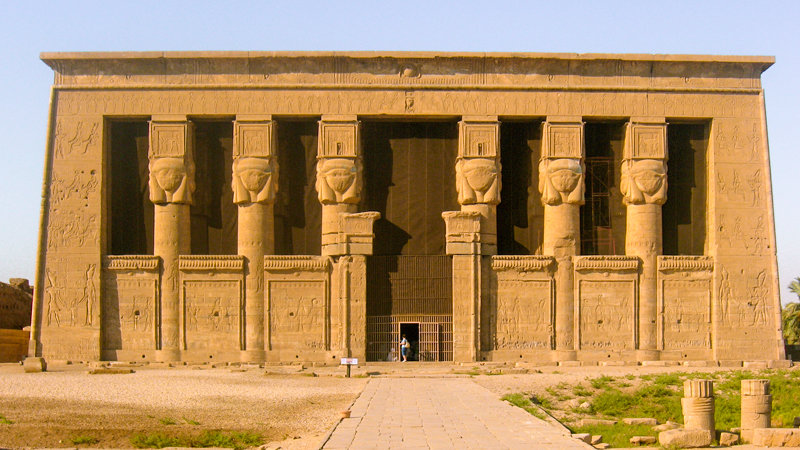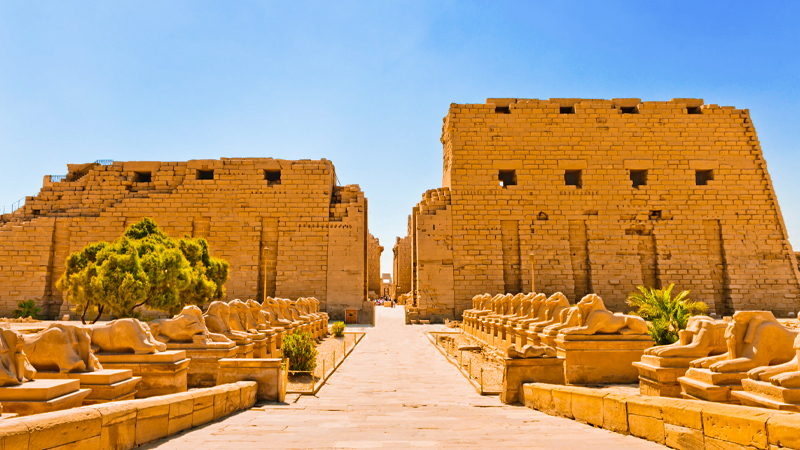Towering against the relentless desert sands, the ancient Egyptian temples stand as enduring testaments to a civilization obsessed with the divine and the eternal. These architectural marvels, meticulously crafted from colossal blocks of stone, served as far more than mere places of worship. They were microcosms of the universe, bustling centers of religious rituals, and powerful symbols of the pharaoh's divinely ordained rule.
But delve deeper, and you'll discover a fascinating diversity in these structures. Dedicated to a pantheon of gods and goddesses, some temples honored the likes of Osiris, lord of the underworld, or Amun-Ra, the sun god. Others served as grand mortuary complexes, where pharaohs were prepared for their journey into the afterlife. These temples, like the Valley of the Kings, became elaborate tombs adorned with hieroglyphic stories and scenes depicting the pharaoh's passage into eternity.
Step inside, and marvel at the sheer scale. Towering hypostyle halls supported by colossal pillars lead to inner sanctuaries bathed in a mystical half-light. Every surface is a canvas, adorned with intricate hieroglyphs and vibrant paintings that whisper tales of mythology, rituals, and offerings. The very architecture itself is symbolic, with towering pylons framing the entrance, representing the gateway between the human realm and the divine.
Types of Egyptian Temples
Mortuary Temples: Homes for Eternity
Dedicated to the afterlife journey of pharaohs
Linked the earthly and divine realms
Example: Mortuary Temple of Hatshepsut
Sun Temples: Abodes of Light
Dedicated to the sun god Ra or Amun-Ra
Designed to capture the sun's rays
Example: Sun Temple of Niuserre (now in ruins)
Mystery Temples: Sites of Initiation and Transformation
Purpose involved initiation rituals
Example: Temple of Kom Ombo with its double sanctuary
Evolution of Design: A Testament to Time
Egyptian temple design wasn't static. Throughout millennia, dynasties left their unique mark. The Old Kingdom witnessed the rise of pyramid complexes, with mortuary temples forming an integral part of the larger structure. The Middle Kingdom saw a shift towards more elaborate decoration and the use of mudbrick alongside stone. The New Kingdom ushered in an era of colossal temples, with towering hypostyle halls supported by massive columns. The influence of foreign powers during the Ptolemaic era is also evident in some temples, showcasing a blend of Egyptian and Greco-Roman styles.
These temples stand as testaments to the enduring legacy of Egyptian civilization. Each structure, with its unique design and purpose, offers a window into the beliefs, rituals, and artistic brilliance of a bygone era. As we delve deeper into these wonders, we embark on a captivating journey through time, unraveling the stories etched in stone.

Decoding Egyptian Temple Symbolism
Hieroglyphs and Beyond: Egyptian temples are filled with hieroglyphs, a writing system that combines sounds and symbols. These symbols tell stories, honor the gods, and guide the deceased in the afterlife.
Nature's Bounty:
Lotus flower: Represents purity and rebirth, like the Nile River, the source of life.
Scarab beetle: Represents the rising sun and the cycle of life because it pushes dung like a rolling sun.
Winged sun disk: Combines a falcon (god Horus) and a sun disk, signifying the Pharaoh's connection to the sun god Ra.
Statues and Sphinxes:
Pharaoh statues: Reinforce the concept of divine kingship and the Pharaoh's continued presence.
Sphinxes: Guard the sacred space from evil forces.
Exploring the Masterpieces: Must-See Egyptian Temples
Egypt boasts a treasure trove of temples, each a testament to the ingenuity and deep faith of its ancient civilization. Whether you're a seasoned traveler, a history buff, or a curious student, there's a temple waiting to be explored. Here are some of the most famous and significant ones:
For Travelers:
Karnak Temple (Luxor): Nicknamed the "Open Air Museum," this sprawling complex is a must-see for its sheer scale and architectural wonders. Walk through towering hypostyle halls, marvel at the Avenue of Sphinxes, and explore the chapels dedicated to various deities.
Luxor Temple (Luxor): Located on the banks of the Nile River, Luxor Temple boasts a dramatic entrance framed by colossal pylons. Step into the sun-drenched courtyards and admire the hieroglyphic inscriptions that adorn its walls.
Abu Simbel (Abu Simbel): Witness the architectural marvel of Abu Simbel, where colossal statues of Ramses II guard the entrance to two rock-cut temples. This UNESCO World Heritage Site is a true marvel of engineering and artistic expression.
For History Lovers:
Mortuary Temple of Hatshepsut (Deir el-Bahri): This unique temple complex, built by the powerful female Pharaoh Hatshepsut, rises majestically from the desert cliffs. Explore its terraces adorned with reliefs depicting her reign and journey to the afterlife.
Kom Ombo Temple (Kom Ombo): Dedicated to two deities, Sobek the crocodile god and Horus the falcon god, this temple features an unusual double sanctuary layout. Explore its well-preserved halls and learn about the fascinating mythology surrounding these two gods.
Edfu Temple (Edfu): One of the most well-preserved temples in Egypt, Edfu offers a glimpse into the Ptolemaic era. Admire its towering pylon, hieroglyphic-filled halls, and sanctuaries dedicated to Horus, the falcon god.
For Students:
Valley of the Kings (West Thebes): Delve into the heart of the Theban Necropolis and explore the underground tombs of pharaohs from the New Kingdom. Witness the elaborate decorations and hieroglyphic texts that offer insights into Egyptian funerary practices and beliefs in the afterlife.
Temple of Seti I (Abydos): This beautifully preserved temple, dedicated to Osiris, the god of the underworld, offers a wealth of information about Egyptian religious beliefs. Explore its halls adorned with scenes from the Book of the Dead, an ancient text guiding the deceased through the afterlife.
Dendera Temple (Dendera): Located on the west bank of the Nile, Dendera Temple is known for its Greco-Roman influences and its well-preserved ceilings adorned with astronomical and religious symbols. Study these intricate details to gain a deeper understanding of Egyptian cosmology and their relationship with the heavens.
This is just a taste of the many incredible Egyptian temples waiting to be explored. Each one offers a unique window into the fascinating world of ancient Egypt.

The Enduring Allure of Egyptian Temples
Egyptian temples stand as silent sentinels, whispering tales of a civilization long gone. They were far more than places of worship; they were centers of life, reflecting the Egyptians' history, culture, and beliefs in intricate carvings and grand architecture.
These structures continue to inspire awe with their scale, artistic detail, and engineering marvels. Studying them allows us to step back in time and understand how the Egyptians lived, worshiped, and viewed the afterlife.
In Conclusion
Verily, the temples of the Nile valley stand as enduring monuments to the faith and artistry of the ancient Egyptians. These sacred precincts were not merely houses of the gods, but vibrant hubs where life and ritual intertwined. Within their hallowed halls, pharaohs sought divine favor, while the faithful brought offerings and witnessed ceremonies that mirrored the grand dramas of the cosmos. Thus, these temples served as testaments to both the earthly and the divine, forever etching the beliefs and aspirations of a bygone era upon the sands of time.

